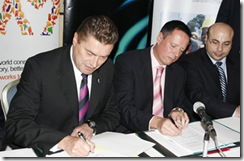Following the launch of the merged Nokia Siemens Networks (NSN) in February 2007, the vendor was quick to communicate its presence across markets as a well-integrated, agile technology provider that is sympathetic to the commercial and technological pressures network operators are under. Despite having lost its founding CEO Simon Beresford-Wylie in September 2009, and been hit hard by the effects of the global economic slowdown in 2009, NSN maintains a steely determination as it looks to maximise emerging market opportunities
Erlemeier faces the challenge of restoring NSN’s sales in the MEA region after they suffered a significant decline last year. He is confident the vendor has the tools necessary to achieve this
The entire telecom vendor community felt the impact of the economic downturn in 2009, with top-line revenues as well as margins being placed under significant pressure. Nokia Siemens Networks’ (NSN) operations in the MEA region were amongst the most significantly impacted, with the supplier reporting a 39.7 per cent decrease in Q409 sales year-on-year in the region. It was the steepest fall in sales of any of NSN’s regional markets, eclipsing Europe’s 18.9 per cent sales decline over the same period, and Asia Pacific’s 15.4 per cent fall.
It is now the responsibility of Jorg Erlemeier, head of the MEA region since October 1, 2009 to reverse the sales trend and push NSN along in a geography that has the potential to rebound beyond the global average.
“The telecom infrastructure market in the region had gone down dramatically (in 2009),” says Erlemeier, frankly. “However, overall we see recovery in terms of infrastructure investments as operators’ CAPEX begins to increase again.”
Erlemeier forecasts that CAPEX in the region will reach the highs last experienced in 2008 by 2011 and describes the MEA region as having a host of opportunities that NSN can seize upon.
“Our strong, established footprint in the region is definitely one of our competitive advantages, though we can never be satisfied with our position, we are always looking for further growth.” Erlemeier says.
Erlemeier claims that NSN is the leader in 3G with a majority of its customers and is keen to maintain that position with the strong support of managed services. NSN supplied Qatar Telecom (Qtel) with its unique Single RAN offering, including its Flexi Multiradio base stations and all-IP backhaul technology, and continues to operate Qtel’s network under an existing managed services contract, for example.
“Services is a strong point for NSN to go into new markets with,” Erlemeier comments. “The offer of managed services is about identifying what are the pain points for network operators and providing solutions to them. The more experienced operators are more pro-active in this regard, but we still find situations where RFQ (Request for Quotation)-type approaches to managed services are required.”
While vendor financing has played a less prominent role in the development of networks across much of the MEA in recent years as a result of the rapid growth in subscribers and resultant cash-positive positions of many operators in the Middle East in particular, the tightened global credit market of recent times has brought vendor financing arrangements back into focus.
At the end of March, the UAE’s Du entered into a €200 million (US$270 million) long term credit facility with NSN, in order to finance future network upgrades and expansion.
The agreement is backed by Finnvera, the Finnish Export Credit Agency, and will be provided through Nordea Bank for the purchase of NSN equipment. NSN is the major supplier to integrated operator Du for 2G and core works.
The high proportion of hybrid/integrated operators in the Middle East in particular, offers greater opportunities as well as challenges, as consumers look to receive the best service and products irregardless of the technology complexities that may exist in delivering them. There is thus much to be gained by greater efficiencies, with optimisation solutions becoming an art form as they help to drive overall costs down.
“Operators have definitely become cautious about investments, and the question is where the next wave is going,” comments Erlemeier. “2010 is an interesting year with something like 25 3G licences coming up in the MEA region, and the move to LTE will also play a role.” 
NSN’s CEO Rajeev Suri took over the company late last year, and was immediately faced by the challenges brought about by the reduction in CAPEX by operators around the world as a result of the global economic downturn
Mobile broadband and the growth in the uptake of smartphones are also areas that Erlemeier forecasts will positively impact the development of the telecom sector though a key question of the developing ecosystem will remain how network providers best monetise the ongoing data explosion taking place in many parts of the world including the MEA.
Collaborative solutions are likely to be the most successful, as Internet/content companies look to invest in capacity and smartphones, with the key word in the evolution of applications and services being ‘trust’ Erlemeier suggests.
“Banks and communications service providers are given the most trust at the moment, and this trust needs to be an element that exists across the entire mobile broadband value chain if it is to succeed,” Erlemeier suggests.
Like any vendor covering a geography has wide in scope as the MEA region, NSN’s future lies in adaptability and an ability to understand the various stages at which different markets in the region are at. The GCC region, for instance, is driven by service providers seeking a position of technology leadership, where such players are keen to move towards the next technology implementation. Markets in Africa, however, have to be watched closely as medium and long-term prospects evolve and outsourced services gather pace.
The acquisition of the majority of Zain Group’s mobile telecom assets in Africa by Bharti of India is a development that will garner much interest as to ways in which operators on the continent look to run networks profitably in low ARPU markets. Network optimisation and cost control is likely to rank very highly on the list of priorities Bharti needs to get right, and having had decent experience of these dynamics through operating successfully in India, the operator is well placed to make inroads in its acquired business should it overcome the cultural chasm between Africa and India.
Last November NSN signed multi-vendor network outsourcing agreements with Zain for a number of operators in East Africa, one of the first times such arrangements had been undertaken on the continent
NSN is also a leading developer and supporter of green energy solutions, which are no longer being pushed merely as eco-friendly propositions, but instead as viable commercial alternatives, particularly in off-grid situations.
Last November NSN unveiled a set of green energy solutions that the vendor believes will help telecom operators cut operating costs and power consumption significantly. NSN has already deployed many hundreds of renewable energy sites worldwide, using its Flexi base station, which consists of six elements including: energy modernisation; off-grid site solution; bad-grid site solution; energy efficiency consulting; green energy control and energy OPEX management.
Erlemeier believes network operators in the region have strong support from the vendor community with respect to technology choices, and whether a provider is interested in sweating its EDGE network before migrating to 3G and LTE, or is still investing in 3G, he believes NSN is placed strongly to assist in such choices.
“I believe LTE will become a commercially reality in LTE in the 2011/2012 timeframe,” he forecasts. “However at that time there will be a great deal of co-existence between GSM, 3G and LTE,” he adds.
Like other telecom technology vendors, NSN is confident the mass upgrade of networks to LTE is a question of time rather than a question of whether it will or will not happen, given that the technology is a cheaper way to higher capacity.
“Media transport may be the tipping for LTE,” Erlemeier suggests.
With respect to the competitive landscape amongst vendors with strong positions in the MEA region, Erlemeier believes that competition is growing all the time and it is in the interests of all participants to try and avoid a price war. He is reassured by the fact that many network operators view price as only one element in their selection process and that other factors including service quality and reliability are also considered highly.
NSN has operations in 45 out of 68 countries in the MEA, which is a footprint large enough to reaffirm its commitment to the region.
NSN awarded network outsourcing deal by Zain
Last November Zain announced the award of three network outsourcing deals to NSN for a number of its African assets at the time.
Under the agreements, NSN picked up a five-year management contract in Kenya, Tanzania and Uganda, with an eye to optimising, modernising and managing 3,000 plus multi-vendor mobile sites catering to nine million customers. Upgrades to energy efficient technologies and off-grid power solutions were a key component of the deal.
The contract marked NSN’s biggest multi-vendor outsourcing deal in the region and was also one of the first such deals of its kind in Africa. As part of the agreement, approximately 350 Zain employees were transferred to NSN.





0 comments ↓
There are no comments yet...Kick things off by filling out the form below.
Leave a Comment